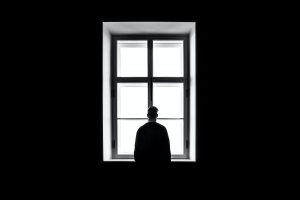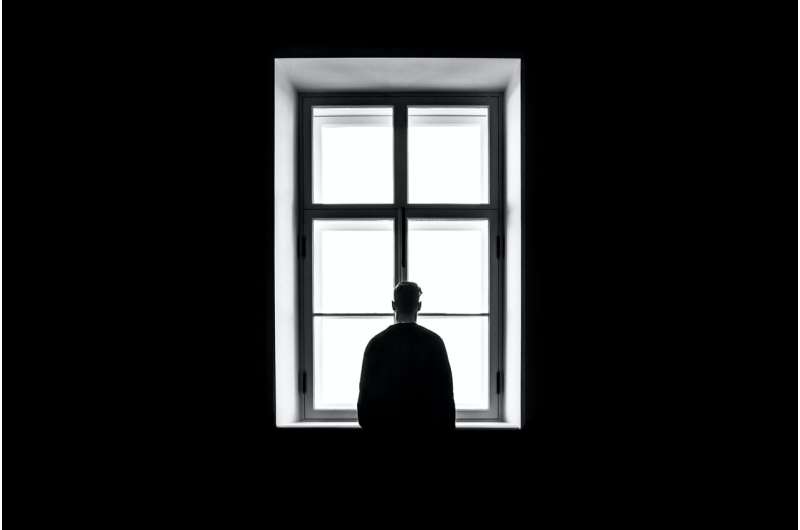Q&A: How social isolation, loneliness can shorten your life


Loneliness and social isolation are on the rise in the U.S., but as we take steps to find remedies, a new study reminds us that the two are separate problems, often linked (sometimes in surprising ways) but not always, and have different potential impacts. Being socially isolated carries much greater physical health risks but loneliness has a larger impact on mental-health-related conditions.
The Gazette spoke with Tyler VanderWeele, the John L. Loeb and Frances Lehman Loeb Professor of Epidemiology at the Harvard T.H. Chan School of Public Health, director of Harvard’s Human Flourishing Program at the Institute for Quantitative Social Science, and senior author of the study, which appeared in the journal SSM—Population Health in September. The program is sponsoring a conference on fighting loneliness and social isolation, “Building Connected Communities,” in October.
GAZETTE: How big a problem are loneliness and social isolation today?
VANDERWEELE: The measures and metrics differ, and it depends on what aspects you’re looking at, but on a number of separate assessments, about 50 percent of Americans report being lonely. We could use more stringent thresholds but even then, a sizable portion of the population say they experience moderate amounts of loneliness. We have good evidence that loneliness has been increasing in this country for the last couple of decades in at least moderate amounts for a substantial number of people.
GAZETTE: Is that trend mirrored by social isolation?
VANDERWEELE: We have much better data, going further back, on community participation and social isolation. Trends over the past several decades show less community participation and more people living alone. Religious service attendance has fallen dramatically, and marriage rates are down. It’s not all bleak, though. Volunteering, for example, is recently up a little bit. However, on the whole, if one looks at these objective measures of engagement with other people, it mirrors the loneliness statistics. The declines in social engagement and community participation started decades ago, and many of those trends have continued.
GAZETTE: What is the difference between loneliness and social isolation?
VANDERWEELE: The distinction has to do with objective versus subjective aspects of social connectedness. Social isolation refers, objectively, to whether you are spending time with people and/or in communities. Are you living with people or not? Are you engaging with various forms of community life? Are you spending time with friends and family?
The phenomenon of loneliness is one’s subjective sense as to whether relationships and community involvements fulfill the deep, intrinsic need almost everyone feels for social connection. Are social relationships sufficient to meet the desire to be with other people, to be understood by other people, to be loved by other people?
GAZETTE: Is it possible to be socially isolated but not lonely?
VANDERWEELE: It’s clear from the research that people have different social needs. Some people may have much less need for connection than others. They may have one close friendship, enjoy spending time alone, and feel that’s sufficient for their needs for companionship. So, loneliness and social isolation are correlated, but the correlation is not perfect.
There are people who spend a lot of time with others but still feel lonely, that they’re not understood, not loved, and other people who spend comparatively little time with others but feel that what they have fulfills their needs.
Somewhat counterintuitively, when you become very lonely, you actually tend to withdraw further from community. Loneliness can make it seem like relationships are threatening or dangerous, or that you’re going to feel even more lonely among people because you’re not going to find the connection that you want.
In our study, along with other outcomes, we also looked at the effect of social isolation on loneliness, and loneliness on social isolation. Each contributes detrimentally to the other. It’s perhaps not surprising that if you’re socially isolated you’re likely to become more lonely. That makes sense. What’s perhaps more surprising is that when you become lonely, over time you’ll actually tend to withdraw and become more socially isolated, not less. And what’s really striking is the effect of loneliness on increasing social isolation is even larger than the effect of social isolation on loneliness. So, loneliness has this counterintuitive aspect to it. You see it also in the results—by John Cacioppo, James Fowler, and Nicholas Christakis looking at social networks—that loneliness is contagious. So, if you’re spending time with lonely people, you’re actually more likely to become lonely.
GAZETTE: Let’s shift to your study, which appeared in Population Health. What did you find?
VANDERWEELE: Among a group of older adults, we controlled for prior relational and social connection history and numerous other social, psychological, demographic, and health-related factors. Then we looked at how loneliness changed and how social isolation changed over a four-year period.
Similar to many other studies, we found evidence for effects of both loneliness and social isolation on a large number of outcomes. Those who were more lonely were about 40 percent more likely to die over the next four years, while those who were socially isolated were about 75 percent more likely to die.
It’s important to understand the context. This is a group of older adults, and living alone and being isolated is perhaps especially dangerous for them given the higher likelihood of health troubles.
Likewise, we found effects of both loneliness and social isolation on physical function limitations, on happiness, on one’s sense of optimism, on one’s sense of purpose in life, as well as various other mental health outcomes, like depression, or having a sense of hope.
One of the interesting aspects of our study is that we were able to look at these two conditions simultaneously, and it appeared that each had independent effects when controlling for the other. So if you just address one, you haven’t done all that you can with regard to improving health and well-being. There are independent contributions of each, so both are important to address.
Another interesting thing we found is that, while both loneliness and social isolation had important impacts on health and well-being, which of them was more prominent varied by the outcome. So, with these older adults in the United States, being socially isolated was the more important factor for physical health outcomes, like risk of death and limitations on physical functioning, but loneliness was more important for mental health and well-being outcomes like depression or happiness, purpose in life, and having a sense of mastery. Social isolation is relevant for those as well, but the effects were smaller than for loneliness. These differences were another intriguing aspect of our study.
GAZETTE: Can we quantify those effects?
VANDERWEELE: If we look at depression, for example, those who were socially isolated had about a 35 percent increase in likelihood of depression four years later, controlling for baseline depression. That’s substantial and important. But those experiencing loneliness had more than a 2½-fold increase in the likelihood of depression. That was quite striking. Likewise, there was about twice as large an effect on hopelessness for being lonely versus being socially isolated. Loneliness was more powerful. Similarly with purpose in life: Both are relevant, but loneliness had about twice as large a negative effect as did social isolation.
GAZETTE: Is it important, then, to distinguish between loneliness and social isolation when you devise interventions?
VANDERWEELE: It’s helpful to distinguish between the two because the ways we might try to address these—at either an individual level or at a societal level—are quite different. Again, we’re looking at objective aspects versus subjective aspects: Do you spend time with people versus do you really feel connected to them?
For loneliness, one of the more effective interventions is cognitive behavioral therapy. That’s very different from—for social isolation—building communities, spending time with people, making sure someone checks in a couple of times a week to identify areas of need. But I wouldn’t exclusively prioritize one set of interventions over the other. Both are relevant and both are real risk factors.
Taking a step further back, another big question is, “Do we value relationships and community sufficiently here in in the United States?” We’ll have more definitive data in a few months’ time, as our global flourishing study completes its first wave of data collection.
We’ve been asking not just how socially connected subjects feel, but how much they value social connection. In many of the samples, both in terms of how much social connection individuals feel and how much they value it, the U.S. seems lower than almost all other countries where we’ve collected data. We tend to be much more individualistic than other countries and that makes relationships and community life more challenging.
It’s worth reflecting on this both in its own right and because we have seen these powerful effects of loneliness and social isolation. There is something about relationships, social connectedness, community life, that is central to what it is to be human, what it is to flourish. So, while freedom and autonomy are important values, there are tradeoffs, and it’s worth reflecting on what the right balance is and how we should structure our lives, both as individuals and as a society.
More information:
Joanna H. Hong et al, Are loneliness and social isolation equal threats to health and well-being? An outcome-wide longitudinal approach, SSM—Population Health (2023). DOI: 10.1016/j.ssmph.2023.101459
Provided by
Harvard University
This story is published courtesy of the Harvard Gazette, Harvard University’s official newspaper. For additional university news, visit Harvard.edu.
Source: Read Full Article